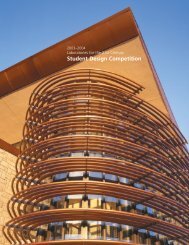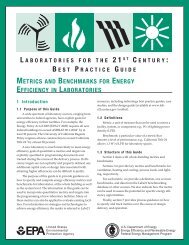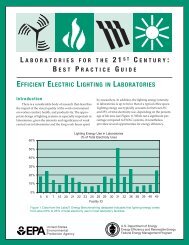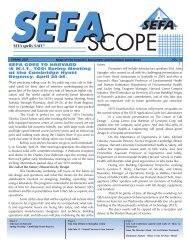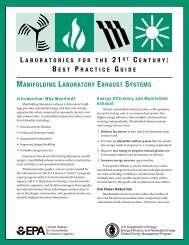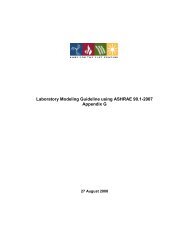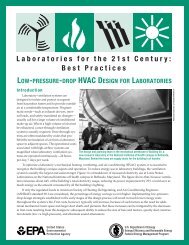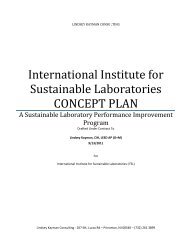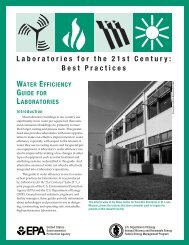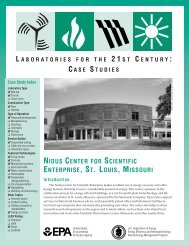Results of the 2012 S-Lab Awards and Conference The Effective ...
Results of the 2012 S-Lab Awards and Conference The Effective ...
Results of the 2012 S-Lab Awards and Conference The Effective ...
You also want an ePaper? Increase the reach of your titles
YUMPU automatically turns print PDFs into web optimized ePapers that Google loves.
Imperial College’s award-winning Continuous Commissioning programme (see p.14)<br />
certainly shows <strong>the</strong> benefits <strong>of</strong> investing in a systematic approach to ventilation<br />
improvement. Changing user attitudes <strong>and</strong> behaviour can also make a big difference,<br />
for example, by encouraging sash closure on VAV fume cupboards (see a Manchester<br />
Metropolitan University example on p.15).<br />
<strong>The</strong> Lean <strong>Lab</strong>oratory<br />
Shaun White, <strong>of</strong> <strong>the</strong> Food <strong>and</strong> Environment Research Agency (FERA), attributed its<br />
successful transition from primarily governmental to semi-commercial to a wide<br />
ranging continuous improvement programme. This includes innovative employment<br />
policies <strong>and</strong> a common laboratory information management system (LIMS) which<br />
enables much better sharing <strong>of</strong> data <strong>and</strong> tracking <strong>of</strong> delivery. Many o<strong>the</strong>rs are<br />
travelling a similar path, sometimes applying <strong>the</strong> concepts <strong>of</strong> lean manufacturing<br />
to laboratory operations, <strong>and</strong>/or adopting formal systems such as <strong>the</strong> ISO 9001<br />
quality management system (see Plymouth University example on p.18). Continuous<br />
improvement can also be incentivised by more transparent accounting for central<br />
services, e.g. by charging for space, energy <strong>and</strong> o<strong>the</strong>r resources, or sharing a portion<br />
<strong>of</strong> any savings that fall under central budgets with departments or individuals.<br />
Financial <strong>and</strong> O<strong>the</strong>r Benefits from Chemical <strong>and</strong> Sample Management<br />
<strong>The</strong>re is certainly much more intensive recording, tracking <strong>and</strong> analysis <strong>of</strong> laboratory<br />
operations than in <strong>the</strong> past. Chemical management systems such as that <strong>of</strong> <strong>the</strong><br />
University <strong>of</strong> Edinburgh (as described in an S-<strong>Lab</strong> case study) can save hundreds <strong>of</strong><br />
thous<strong>and</strong>s <strong>of</strong> pounds in larger labs by reducing wastage, <strong>and</strong> provide o<strong>the</strong>r benefits<br />
such as faster chemical access for researchers.<br />
More effective sample storage <strong>and</strong> management can also reduce overall dewar, fridge<br />
<strong>and</strong> freezer requirements by ensuring that only wanted samples are stored. Toge<strong>the</strong>r<br />
with o<strong>the</strong>r measures, such as using storage space efficiently; storing materials at <strong>the</strong><br />
highest temperature that meets preservation requirements; maintaining cold storage<br />
devices so that <strong>the</strong>y operate efficiently; <strong>and</strong> only purchasing very energy efficient<br />
models, great savings can be made. Bob Nicholson’s presentation highlighted how<br />
a programme <strong>of</strong> replacing older freezers with very energy efficient models at <strong>the</strong><br />
University <strong>of</strong> Newcastle saved £13,000 <strong>and</strong> 70 tonnes <strong>of</strong> CO 2<br />
emissions a year, <strong>and</strong><br />
freed up space by replacing chest with upright models.<br />
Can <strong>Lab</strong>oratory Informatics Deliver Benefits?<br />
Andrew Platt highlighted <strong>the</strong> benefits <strong>of</strong> a LIMS - including more accurate <strong>and</strong><br />
st<strong>and</strong>ardised information, <strong>and</strong> better security - in managing over 200,000 samples<br />
in <strong>the</strong> University <strong>of</strong> Manchester’s CIGMA unit. <strong>The</strong> holy grail for practitioners is linking<br />
LIMS, electronic lab notebooks (ELN) <strong>and</strong> o<strong>the</strong>r lab IT systems toge<strong>the</strong>r into a unified<br />
laboratory IT architecture, which also interfaces with organisation-wide systems such as<br />
document storage.<br />
<strong>The</strong> claimed benefits include smoo<strong>the</strong>r, easier workflows with less manual effort <strong>and</strong><br />
duplication <strong>of</strong> data entry; error reduction; reduced IT development <strong>and</strong> support cost;<br />
better data management <strong>and</strong> recording (e.g. to demonstrate compliance, or support<br />
patent applications) <strong>and</strong> greater security. However, progress is impeded by a lack <strong>of</strong><br />
common communication, data transfer <strong>and</strong> terminology st<strong>and</strong>ards, <strong>and</strong> fragmentation <strong>of</strong><br />
knowledge <strong>and</strong> interest around specific systems.<br />
Keynote Jeremy Frey stressed <strong>the</strong> advantages <strong>of</strong> ELNs in providing background<br />
information about intentions, context, problems surmounted etc. This can sometimes<br />
be as or more important than science data itself to subsequent researchers, <strong>and</strong> also<br />
important in providing reassurance that findings are not fraudulent. He also highlighted<br />
<strong>the</strong> benefits <strong>of</strong> ELN integration with o<strong>the</strong>r processes (e.g. health <strong>and</strong> safety plans which<br />
<strong>of</strong>ten provide details <strong>of</strong> intentions, set ups etc.) <strong>and</strong> o<strong>the</strong>r IT systems.<br />
“Good inventory<br />
management<br />
<strong>of</strong> chemicals,<br />
samples <strong>and</strong> o<strong>the</strong>r<br />
resources isn’t<br />
glamorous, but it<br />
can save millions<br />
<strong>of</strong> pounds across <strong>the</strong> UK through<br />
better knowledge <strong>of</strong> what’s being<br />
used or stored, <strong>and</strong> reducing<br />
unnecessary activities <strong>and</strong> waste.”<br />
Lisa Hopkinson, former S-<strong>Lab</strong><br />
Project Manager, now Director,<br />
Lorax Environmental Associates<br />
“Integrated<br />
laboratory IT can<br />
improve science<br />
productivity<br />
<strong>and</strong> quality. For<br />
example, ambient<br />
temperature<br />
can be important metadata for<br />
experiments. Collecting this<br />
automatically from a BMS can<br />
improve analysis <strong>and</strong> avoid setting<br />
up parallel systems.”<br />
Jeremy Frey, Pr<strong>of</strong>essor <strong>of</strong><br />
Physical Chemistry, University <strong>of</strong><br />
Southampton<br />
“Cloud computing<br />
can be cheaper,<br />
greener, <strong>and</strong><br />
more secure if<br />
done in <strong>the</strong> right<br />
way. It will have a<br />
pr<strong>of</strong>ound impact in<br />
areas such as High Performance<br />
Computing (HPC) <strong>and</strong> storage, <strong>and</strong><br />
make it much easier for smaller<br />
institutions to do quality science<br />
research.”<br />
Rob Bristow, Programme Manager,<br />
JISC (<strong>the</strong> IT support body for UK<br />
universities <strong>and</strong> colleges)<br />
<strong>The</strong> University <strong>of</strong> Southampton’s <strong>Lab</strong>Trove project is a step towards this by providing<br />
6



